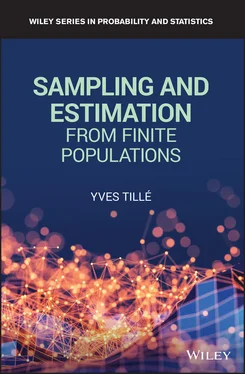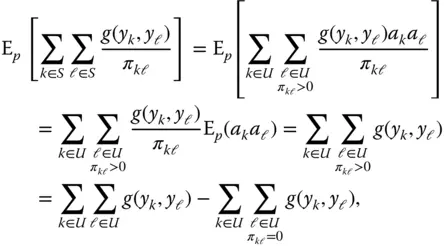Yves Tille - Sampling and Estimation from Finite Populations
Здесь есть возможность читать онлайн «Yves Tille - Sampling and Estimation from Finite Populations» — ознакомительный отрывок электронной книги совершенно бесплатно, а после прочтения отрывка купить полную версию. В некоторых случаях можно слушать аудио, скачать через торрент в формате fb2 и присутствует краткое содержание. Жанр: unrecognised, на английском языке. Описание произведения, (предисловие) а так же отзывы посетителей доступны на портале библиотеки ЛибКат.
- Название:Sampling and Estimation from Finite Populations
- Автор:
- Жанр:
- Год:неизвестен
- ISBN:нет данных
- Рейтинг книги:4 / 5. Голосов: 1
-
Избранное:Добавить в избранное
- Отзывы:
-
Ваша оценка:
Sampling and Estimation from Finite Populations: краткое содержание, описание и аннотация
Предлагаем к чтению аннотацию, описание, краткое содержание или предисловие (зависит от того, что написал сам автор книги «Sampling and Estimation from Finite Populations»). Если вы не нашли необходимую информацию о книге — напишите в комментариях, мы постараемся отыскать её.
Sampling and Estimation from Finite Populations Provides an up-to-date review of the theory of sampling Discusses the foundation of inference in survey sampling, in particular, the model-based and design-based frameworks Reviews the problems of application of the theory into practice Also deals with the treatment of non sampling errors
is an excellent book for methodologists and researchers in survey agencies and advanced undergraduate and graduate students in social science, statistics, and survey courses.

 is known, it is recommended to use the estimator of Hájek (1971) (HAJ) which consists of dividing the total by the sum of the inverses of the inclusion probabilities:
is known, it is recommended to use the estimator of Hájek (1971) (HAJ) which consists of dividing the total by the sum of the inverses of the inclusion probabilities:
 then
then  Therefore, the bad property of the expansion estimator is solved because the Hájek estimator is linearly invariant. However,
Therefore, the bad property of the expansion estimator is solved because the Hájek estimator is linearly invariant. However,  is usually biased because it is a ratio of two random variables. In some cases, such as simple random sampling without replacement with fixed sample size, the Hájek ratio is equal to the expansion estimator.
is usually biased because it is a ratio of two random variables. In some cases, such as simple random sampling without replacement with fixed sample size, the Hájek ratio is equal to the expansion estimator.

 be the vector of dilated values:
be the vector of dilated values:





 be a function from
be a function from  to
to  . A necessary and sufficient condition for
. A necessary and sufficient condition for

 for all
for all 

 for all
for all 


 for all
for all  then the estimator is always positive. This condition is called the Yates–Grundy condition.
then the estimator is always positive. This condition is called the Yates–Grundy condition.










